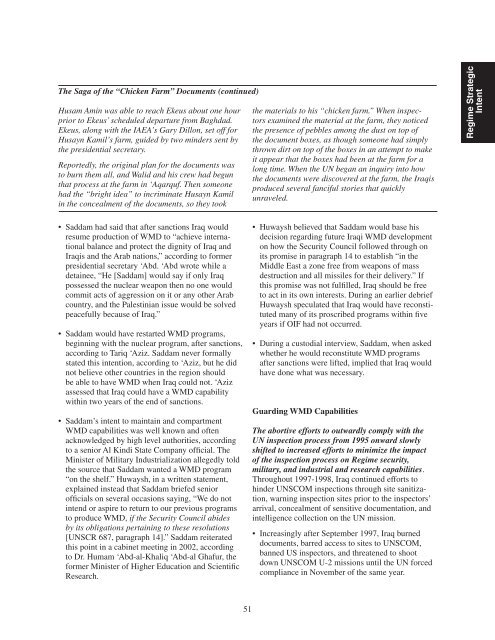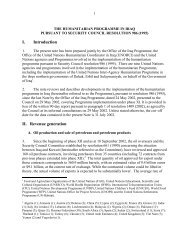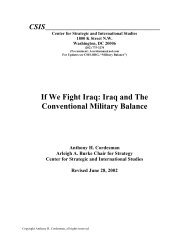- Page 1 and 2:
Comprehensive Reportof the Special
- Page 3 and 4:
versus another. They deserve at lea
- Page 5 and 6:
In Saddam’s view, Iraq was the na
- Page 7 and 8:
UNSCOM gave a sufficiently positive
- Page 9 and 10:
The Regime, drawing on the experien
- Page 12:
December 1998. The United States an
- Page 15:
The new Iraq could benefit from the
- Page 19 and 20:
and the Baath party. This is a volu
- Page 21 and 22:
have been important, though they ha
- Page 24 and 25:
Regime StrategicIntentRegime Strate
- Page 26 and 27:
ContentsKey Findings...............
- Page 28 and 29:
AnnexesA. The Quartet—Influence a
- Page 30 and 31: Key FindingsSaddam Husayn so domina
- Page 32 and 33: Former Iraqi Regime Officials Varie
- Page 34 and 35: Who Made Iraq’s StrategicDecision
- Page 36 and 37: • Tariq ‘Aziz described the req
- Page 38 and 39: • Instead, voluminous files were
- Page 40 and 41: secure Saddam’s support for odd o
- Page 42 and 43: Saddam’s Use of Execution—Manag
- Page 44 and 45: solely for civilian use when the re
- Page 46 and 47: directly and continuously to him. H
- Page 48 and 49: How Saddam Saw HisSubordinatesMinin
- Page 50 and 51: Saddam’s PsychologyHow Saddam Saw
- Page 52 and 53: to consist of was hazy. His drive t
- Page 54 and 55: Iraq’s Use of CW in 1991 Against
- Page 56 and 57: Excerpts from a Closed-Door Meeting
- Page 58 and 59: maker asserted that either country
- Page 60 and 61: Israel“There can never be stabili
- Page 62 and 63: Saddam’s handling of Iraq’s res
- Page 64 and 65: this to the international community
- Page 66 and 67: Regime StrategicIntentNote: Red cel
- Page 68 and 69: Iraq’s Relationship With RussiaTh
- Page 70 and 71: Realizing Saddam’s VeiledWMD Inte
- Page 72 and 73: Selected UN Security Council Resolu
- Page 74 and 75: Husayn KamilBorn in 1955 within the
- Page 76 and 77: ibility with UNSCOM. Iraqi demands
- Page 78 and 79: and the International Atomic Energy
- Page 82 and 83: Security Services (continued)The Sp
- Page 84 and 85: VX Warhead Samples & The Iraqi Air
- Page 86 and 87: success—reduced or suspended oil
- Page 88 and 89: Preserving and Restoring WMD Infras
- Page 90 and 91: • The Regime also sought diplomat
- Page 92 and 93: Renewing UN InspectionsIraq allowed
- Page 94 and 95: never part of the military plan cra
- Page 96 and 97: • Former Minister of Defense Sult
- Page 98 and 99: Annex AThe Quartet—Influence and
- Page 100 and 101: Perceptions of Threat and Challenge
- Page 102 and 103: OverviewAnnex BIraq’s Intelligenc
- Page 104 and 105: Regime StrategicIntentThe Scientifi
- Page 106 and 107: M6, Directorate of Internal Securit
- Page 108 and 109: Structure of M14• Special Operati
- Page 110 and 111: M18, Directorate of ResidencyM18 is
- Page 112 and 113: Structure of M40• M40/1 Monitors
- Page 114 and 115: OverviewAnnex CIraq’s Security Se
- Page 116 and 117: The Special SecurityOrganizationSad
- Page 118 and 119: Regime StrategicIntentThe Special S
- Page 120 and 121: Structure of the SSO Security Branc
- Page 122 and 123: The Republican GuardThe Republican
- Page 124 and 125: The Republican Guard Forces Command
- Page 126 and 127: Annex DSaddam’s Personal Involvem
- Page 128 and 129: [Translator Comment: they are in go
- Page 130 and 131:
Regime Financeand ProcurementRegime
- Page 132 and 133:
ContentsA Word on the Scope of This
- Page 134 and 135:
MIC Banking and Financing .........
- Page 136 and 137:
A Word on the Scope of This Chapter
- Page 138 and 139:
Key FindingsThroughout the 1990s an
- Page 140 and 141:
ents. He made all modifications to
- Page 142 and 143:
Chapter SummaryThe Illicit Finance
- Page 144 and 145:
The Regime TimelineDecline (1991-96
- Page 146 and 147:
OverviewDirecting and Budgeting Ira
- Page 148 and 149:
Regime Financeand ProcurementFigure
- Page 150 and 151:
Iraq’s National Budget 1991-2002A
- Page 152 and 153:
Regime Financeand ProcurementFigure
- Page 154 and 155:
OverviewFinancing Iraq’s IllicitP
- Page 156 and 157:
including abolishing universal empl
- Page 158 and 159:
Behind the scenes, the Iraqi govern
- Page 160 and 161:
for what they imported in 1992, pro
- Page 162 and 163:
Figure 10. Iraq’s estimated earni
- Page 164 and 165:
Regime Financeand ProcurementFigure
- Page 166 and 167:
Regime Financeand ProcurementFigure
- Page 168 and 169:
stated that he believed the Russian
- Page 170 and 171:
documents. Ten other Iraqi embassie
- Page 172 and 173:
were made to at least two Iraqi fro
- Page 174 and 175:
Figure 21. Iraq’s estimated earni
- Page 176 and 177:
SOMO Account Balances Outside of Ir
- Page 178 and 179:
Regime Financeand ProcurementFigure
- Page 180 and 181:
with an *) shows the total proceeds
- Page 182 and 183:
seas accounts in Lebanon and Jordan
- Page 184 and 185:
and the overseas banks forwarded ac
- Page 186 and 187:
assets in employee-named accounts.
- Page 188 and 189:
OverviewExecuting Illicit Procureme
- Page 190 and 191:
necessary to accommodate the large
- Page 192 and 193:
Regime Financeand ProcurementFigure
- Page 194 and 195:
offices, there was only a single em
- Page 196 and 197:
MoD’s Procurement Leadership at t
- Page 198 and 199:
Although other Iraqi ministries wer
- Page 200 and 201:
From 2000 onwards, the RG’s annua
- Page 202 and 203:
Regime Financeand ProcurementFigure
- Page 204 and 205:
The information provided by these t
- Page 206 and 207:
Regime Financeand ProcurementFigure
- Page 208 and 209:
its real activity, which was coordi
- Page 210 and 211:
Regime Financeand ProcurementFigure
- Page 212 and 213:
• In May 2002, ARMOS was offered
- Page 214 and 215:
officer suggested Neptune would be
- Page 216 and 217:
Regime Financeand ProcurementFigure
- Page 218 and 219:
• A foreign intelligence service
- Page 220 and 221:
MIC Research Support at Universitie
- Page 222 and 223:
Regime Financeand ProcurementFigure
- Page 224 and 225:
Figure 51. Sattam HamidFarhan Al-Ga
- Page 226 and 227:
Regime Financeand ProcurementFigure
- Page 228 and 229:
Supplying Iraq With ProhibitedCommo
- Page 230 and 231:
UNSCOM’s Operation Tea Cup (1995
- Page 232 and 233:
• The technology included guidanc
- Page 234 and 235:
Regime Financeand ProcurementFigure
- Page 236 and 237:
Embassy to Jordan in Amman. The fir
- Page 238 and 239:
Regime Financeand ProcurementThis i
- Page 240 and 241:
Since 1991, Iraqi-Turkish trade rev
- Page 242 and 243:
cash through private sector trade o
- Page 244 and 245:
Chinese Assistance in Iraqi Telecom
- Page 246 and 247:
October 2001, Syrian technicians we
- Page 248 and 249:
• Yugoslav Federal also supplied
- Page 250 and 251:
Regime Financeand ProcurementFigure
- Page 252 and 253:
jammers, night-vision devices, and
- Page 254 and 255:
• According to captured documents
- Page 256 and 257:
Transportation Routes From North Ko
- Page 258 and 259:
Regime Financeand ProcurementFigure
- Page 260 and 261:
Regime Financeand ProcurementFigure
- Page 262 and 263:
Materials, Equipment and Services P
- Page 264 and 265:
conflict, President Lukashenko inst
- Page 266 and 267:
Many transactions for prohibited go
- Page 268 and 269:
Importing ProhibitedCommoditiesDece
- Page 270 and 271:
International Commodity Deception:T
- Page 272 and 273:
Disguising the Commodity’s Destin
- Page 274 and 275:
months to reach Baghdad from Bulgar
- Page 276 and 277:
Regime Financeand ProcurementFigure
- Page 278 and 279:
Figure 68. Primary oil smuggling ro
- Page 280 and 281:
Annex ATranslations of Iraq’s Bil
- Page 282 and 283:
An ISG Translation of the 2003 Iraq
- Page 284 and 285:
Benzene for automobiles:If there is
- Page 286 and 287:
Secondly: oil derivativesThe Iraqi
- Page 288 and 289:
Fifteenth:Based on the Jordanian re
- Page 290 and 291:
Figure 1. The Iraq-SyriaTrade Proto
- Page 292 and 293:
Figure 2. Iraq-Syria TradeProtocol
- Page 294 and 295:
Figure 3. The Iraq-TurkeyTrade Prot
- Page 296 and 297:
Figure 3. The Iraq-TurkeyTrade Prot
- Page 298 and 299:
Figure 3. The Iraq-TurkeyTrade Prot
- Page 300 and 301:
Figure 3. The Iraq-TurkeyTrade Prot
- Page 302 and 303:
Annex BKnown Oil Voucher Recipients
- Page 304 and 305:
Oil Allocation RecipientList (conti
- Page 306 and 307:
Oil Allocation RecipientList (conti
- Page 308 and 309:
Oil Allocation RecipientList (conti
- Page 310 and 311:
Oil Allocation RecipientList (conti
- Page 312 and 313:
Oil Allocation RecipientList (conti
- Page 314 and 315:
Oil Allocation RecipientList (conti
- Page 316 and 317:
Oil Allocation RecipientList (conti
- Page 318 and 319:
Oil Allocation RecipientList (conti
- Page 320 and 321:
Oil Allocation RecipientList (conti
- Page 322 and 323:
Oil Allocation RecipientList (conti
- Page 324 and 325:
Oil Allocation RecipientList (conti
- Page 326 and 327:
Oil Allocation RecipientList (conti
- Page 328 and 329:
Oil Allocation RecipientList (conti
- Page 330 and 331:
Oil Allocation RecipientList (conti
- Page 332 and 333:
Oil Allocation RecipientList (conti
- Page 334 and 335:
Oil Allocation RecipientList (conti
- Page 336 and 337:
Key Budgetary ActorsAnnex CIraq’s
- Page 338 and 339:
decision and issued a presidential
- Page 340 and 341:
• The NSC Auditing Division sent
- Page 342 and 343:
Annex DIraq Economic Data (1989-200
- Page 344 and 345:
Figure 8. Sectoralcomposition of Ir
- Page 346 and 347:
Figure 10. Iraq’s Paris Clubcredi
- Page 348 and 349:
Balance of Payments/Exchange RatesE
- Page 350 and 351:
Figure 16. Exchange rateID/USD.Regi
- Page 352 and 353:
Annex EIllicit Earnings Sources and
- Page 354 and 355:
account for half a year each, were
- Page 356 and 357:
Annex FIraqi Oil SmugglingCaptured
- Page 358 and 359:
ISG Translation of an Oil Sale Cont
- Page 360 and 361:
truck to the Turkish border. Althou
- Page 362 and 363:
Figure 22. Contractbetween the Nati
- Page 364 and 365:
Figure 22. Contractbetween the Nati
- Page 366 and 367:
Figure 24. Letter from A.J.Khazamip
- Page 368 and 369:
Figure 25 . Second letterfrom A.J.
- Page 370 and 371:
Figure 27. Contract forpetroleum pr
- Page 372 and 373:
Figure 27. Contract forpetroleum pr
- Page 374 and 375:
Figure 29. Contractbetween al Basha
- Page 376 and 377:
Figure 29. Contractbetween al Basha
- Page 378 and 379:
Figure 31. Telex from aFrench bank
- Page 380 and 381:
Figure 32. Unipack ofParis contract
- Page 382 and 383:
Figure 33. Telex from VitolGeneva t
- Page 384 and 385:
Figure 35. Letter dated 30December
- Page 386 and 387:
Annex GIraq’s Banking Systemdid n
- Page 388 and 389:
Figure 37. Department,department di
- Page 390 and 391:
anks for some transactions in the b
- Page 392 and 393:
Annex HUN Security Council Resoluti
- Page 394 and 395:
• UNSCR 1175 also noted that the
- Page 396 and 397:
Annex ISuspected WMD-Related Dual-U
- Page 398 and 399:
• An electrophoresis system inclu
- Page 400 and 401:
• The MIC initiated direct contac
- Page 402 and 403:
Annex JThe Procurement of Conventio
- Page 404 and 405:
Possible Breaches of UN Sanctions b
- Page 406 and 407:
Letters Dealing With a Planned Visi
- Page 408 and 409:
ack to Baghdad without repair. The
- Page 410 and 411:
specified that the Iraqi attendees
- Page 412 and 413:
• In April 1999, seven Russian en
- Page 414 and 415:
• The letter also indicates that
- Page 416 and 417:
• In another letter, SARA-M refer
- Page 418 and 419:
Possible Belarusian Breaches of UN
- Page 420 and 421:
Possible Syrian Breaches of UN Sanc
- Page 422 and 423:
• A recovered contract dated 20 F
- Page 424 and 425:
9k38 portable air defense systems (
- Page 426 and 427:
Annex KSuspected Intermediary andFr
- Page 428 and 429:
Atera ManufacturingDaei Internation
- Page 430 and 431:
Annex LProcurement AcronymsAcronymA
- Page 432 and 433:
IAFIraqi Armed ForcesIDIraqi DinarI
- Page 434:
TPICTTCUAEUAVUDMHUHFUNUNCCUNDPUNESC
- Page 437 and 438:
Regime Strategy and WMD Timeline Ev
- Page 439 and 440:
Regime Strategy and WMD Timeline Ev
- Page 441 and 442:
Regime Strategy and WMD Timeline Ev
- Page 443 and 444:
Regime Strategy and WMD Timeline Ev
- Page 445 and 446:
Regime Strategy and WMD Timeline Ev
- Page 447 and 448:
Regime Strategy and WMD Timeline Ev
- Page 449:
Regime Strategy and WMD Timeline Ev
















